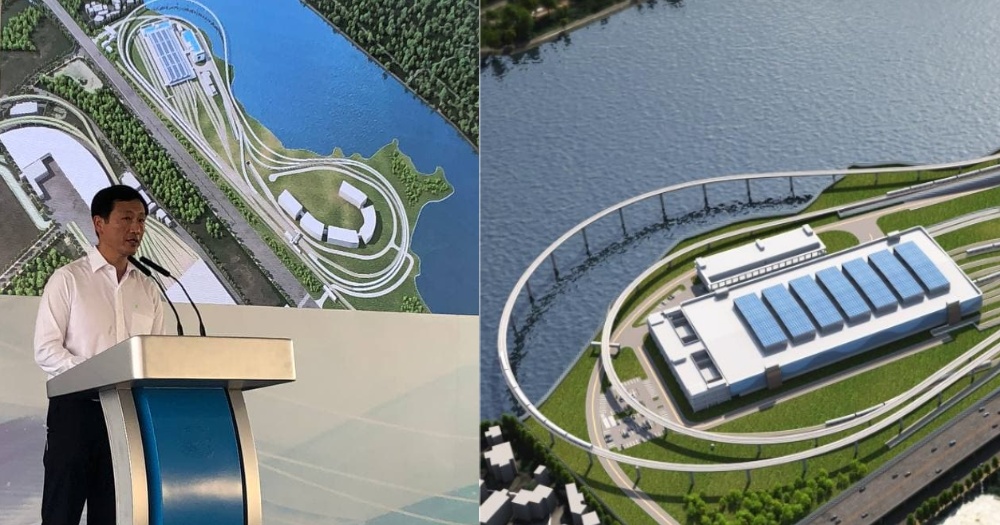The civil construction of the Land Transport Authority's (LTA) Integrated Train Testing Centre (ITTC) commenced on Wednesday (Mar. 17), with a groundbreaking ceremony officiated by Minister for Transport Ong Ye Kung.
The ITTC is a dedicated facility that allows train testing works to be carried out away from the mainline train system, which will reduce the need for the early closure and late opening of train systems to facilitate train testing.
Expected to be fully operational by 2024
The ITTC will occupy a site of approximately 50 hectares, and feature a one-stop workshop for mid-life upgrading and testing of trains before they are deployed on mainline train networks.
"With the troubleshooting capabilities available locally at the ITTC, LTA and the operators will be able to speed up the diagnosis and rectification of faults in Singapore and boost ongoing efforts to maintain rail reliability," LTA said.
The ITTC will house three different types of tracks for specific safety-critical tests, in order to facilitate a comprehensive range of testing modules.
It is expected to be completed in two phases.
The first phase, which includes the construction of the high-speed test track, is targeted to complete in the fourth quarter of 2022, in time to receive the new Circle Line 6 trains in early 2023.
The ITTC will then be fully operational by 2024, with the completion of the two remaining test tracks, the Administration Building, Operations Control Centre Building, and workshops.
"Occasional disruption" is inevitable
Ong has previously brought up the the need to ensure the financial sustainability of Singapore's public transport system in Parliament.
During the groundbreaking ceremony, he said that while raising operational productivity is important in improving financial sustainability, cutting corners on maintenance in order to save cost is "not being productive".
"It is in fact very unproductive, as the remedial action is always disruptive, expensive and costs many times over in social, economic and financial costs," Ong said.
However, he also said that the "occasional disruption" is inevitable, bringing up the major disruption in October 2020.
The disruption was caused by a few "tiny glitches" happening at the same time, Ong explained, which was enough to paralyse a large segment of Singapore's train lines.
According to Ong, LTA and its vendor, Alstom, have completed the forensic investigations of the equipment involved in the disruption, and traced it back to a concurrent failure of the power cables and trip coils along the Tuas West extension.
Ong said that there is likely to be an inherent manufacturing defect, or mishandling during installation of the cables, leading to a cut in the insulation layer, which resulted in a short circuit.
Alstom has since started replacing all the 22kV power cables along Tuas West Extension with cables of higher specifications.
To expedite the replacement, there will be full Sunday closures from Mar. 14 to Mar. 23 on selected stations along Tuas West Extension, and bridging bus services will be provided during the closures.
As for the trip coils, investigations revealed that one of the components, known as a plunger, had rusted, causing the circuit breaker to malfunction.
Forensic investigations assessed that the rust formed was likely caused by an inadequate protective coating, which is likely specific to a particular manufacturing batch.
Ong said that all the trip coils have since been changed after the October 2020 disruption, and will be replaced again with an enhanced design made of stainless steel, by the third quarter of 2022.
Spend where we need to spend
According to Ong, the Mean Kilometres Between Failure (MKBF) of the MRT network is over one million train-km, which is a significant feat.
While he credited part of this achievement to hard work, he also said that a big reason was that more spending went into maintenance, with maintenance expenditure per place km doubling over the last decade.
According to Ong, it is important to "spend where we need to spend", in order to ensure the safety and reliability of the train network.
However, he said that maintenance spending is currently at a "healthy and reasonable level", and that there is no need to spend excessively, as it would not produce better outcomes.
"Instead, we need to understand how small, simultaneous glitches tend to be the causes of big disruptions. This means every part of the system, every worker, every team, no matter how small, is important. That also means everyone plays a part to keep up our standards," the transport minister said.
Top image via Jason Fan and LTA.
If you like what you read, follow us on Facebook, Instagram, Twitter and Telegram to get the latest updates.
